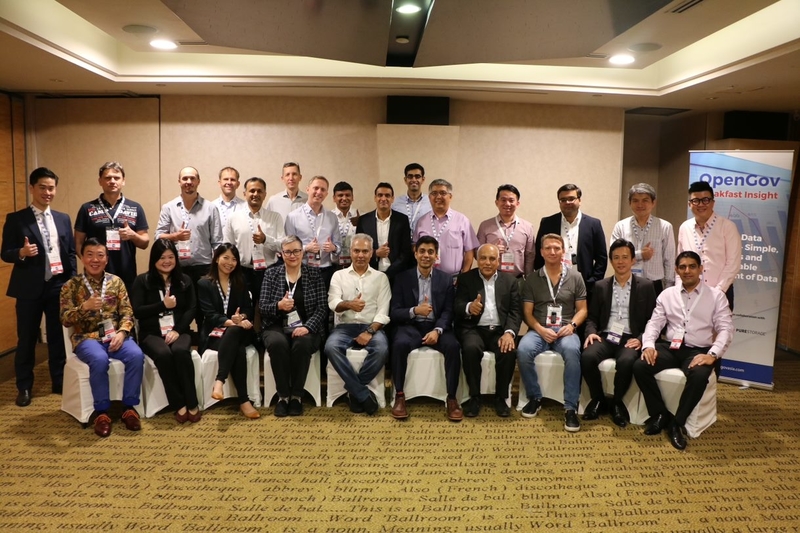
Without doubt, data is seen as a vital asset today for gaining insights into the market and for understanding consumer behaviour.
Data does not act alone; it plays a role in the use of technologies such as cloud services and artificial intelligence (AI). These technologies work hand in hand for managing the inflow and large volumes of data.
The modern data experience leverages the agility and innovation of multiple technologies to allow for better performance – increased productivity and efficiency of organisations.
The financial industry understood this long enough and has been innovating on its systems and working on using technologies to provide better customer experience.
The OpenGov Breakfast Insight on 17 January 2020, held at Amara Singapore, was attended by delegates from the financial services industry who shared their insights on embracing the modern data experience.
Data is the DNA of all technologies

Insights of data are the main thing now, along with Artificial Intelligence (AI), Quantum and other technologies.
Mohit Sagar, Group Managing Director and Editor-in-Chief of OpenGov Asia, shared on AC/DC: a term OpenGov had coined to easily remember its prediction for where innovation and technology are heading toward.
According to this prediction, the trends being seen now are AI, Convergence, Data and Cyber Resilience.
Mohit stressed that data is the DNA of it all. “The insights of data give the flavour of what is going on,” he said.
Data is being collected at rapid speed, either at random or as a continuous process. While data is getting structured, it is also undergoing a metamorphosis, which in this case is data transformation.
Data is getting structured. Consumers are collecting data without even realising it. Bite-sized pieces of data are being collected by the minute, creating a drip-feed of information.
Data is also being recognised as the new hero; it helps to drive information and innovation. But are we trusting it?
In the face of the government, bureaucratic and legal obstacles are reasons for the Public Sector having obstacles to achieving it.
Mohit encouraged the sharing of data as it is now existing as a competitive space. With people being the game-changer, technology has to be enabled together with the empowerment of people.
It is imperative for institutions to find the next platform. Technology is not an expense but instead is a vital part of data transformation.
Challenges will keep coming but they should be apprehended, one at a time.
“Get the right advice, the right stakeholders and the right partners and then be a game-changer.”
Mohit Sagar
Data will be best used and produce the desired results when the right strategies are adopted, to maximise the use of data. Mohit put forth that “adding ice” with more innovations and ideas will be fruitful in achieving the desired outcomes.
Data-driven to Data-centric

The world is moving from data-driven to data-centric. A data-driven approach refers to putting things in silos while a data-driven approach allows data to be used anywhere the user wants to, and for any application.
Sunil Chavan, Vice President of FlashBlade at Pure Storage, shared insights based on conversations with FinTech firms and startups.
From these interactions, it appears that fintech companies have solutions and technology to offer but banks do not have data to provide. This could be due to regulatory issues or data not being available.
Due to such situations, Pure Storage focuses more on providing data-centric services, so that data is free to be used in the way it is intended to be used.
The Digital Transformation journey is undertaken with investments made in 7 key areas which include business intelligence or data analytics solutions, artificial intelligence/machine learning, and cloud services/solutions, according to a Gartner report.
Data is at the heart of it all, impacting areas such as business analytics, cybersecurity, cloud adoption, application modernisation and DevOps, customer experience and AI/machine learning.
Business problems have changed, and open banking is one of them. Open banking requires some microservices-based application development. Without the data to support that or being stuck with latency infrastructure, this creates a gap. New companies, cloud or digital banking organisations are looking at how this can be approached.
Digital transformation is fundamentally made up of four key areas- performance, agility, minimising cost, and reliability.
Sunil added that the next phase of digital transformation will see the adoption of a single data-hub strategy, moving away from data lakes.This strategy will allow for access to information, provide the data to the app and bring it back as intended.
The “Modern Data Experience”, looks at modernising infrastructure with core applications. Sunil added that Pure Storage is potentially one of the first for creating a pre-emptive augmented AI-based data management solution for its customers. Real-time analytics and AI were the DNA for it.
“Embracing the modern data experience is about keeping things fast, using cloud infrastructure, keeping it simple, and subscribing to innovation.”
Sunil Chavan
Data is going to be the game-changer
Kate Carruthers, Chief Data and Insights Officer at UNSW Sydney, shared that data is inherently risky the more you collect. She said that data is not exactly the “next oil”, with oil being a finite resource and data being infinite.
The 5 propositions of data are:

- Data is not neutral
- There is no such thing as raw data
- The signal to noise ratio has changed
- Data is not inherently smart
- The more data we have the less anonymity
Data is not neutral. The selection of one piece of data over another, decisions are made of what data to keep and of what data not to keep.
As a result, there is no such thing as raw data. The signal to noise ratio, with so much data now, it is difficult to get that the signal.
AI and Machine learning are used here due to the sheer scale of data. Data is assumed to be inherently smart.
But data needs to be curated and understood to make the right decisions using it.
Data is currently existing in disconnected silos, instead of being integrated neatly together. It is hard to get data from different sources and place in a common format to be understood. Instead, we are dealing with unformatted data. AI technology is yet unable to navigate this.
The following are the drivers of digital transformation in Australia:
- EU’s revised Payment Services Directive (PSD2)
- General Data Protection Regulation
- Competition and market authorities push for a level playing field
- Fallout from the Banking Royal Commission
But none of it is about customers. Australia is largely driven by regulatory actions. The regulatory framework is changing, and it is driven by the European Union (EU). The EU is setting the agenda for data protection and banking, with its service directives.
The real challenge in Australia is that non-banking competitors are trying to slip into that space and service customers while providing great customer experience. Big banks are unfortunately not doing well to respond to that.
The customer experience will become critical for the new landscape, which will look at the increasing use of microservices. Staring from a customer service orientation will help to drive business. APIs will become fundamental to this.
Ultimately, data is going to be the game changer and digital transformation is founded upon data. This cannot happen without good data. With so much data at hand, AI and machine learning will be needed to gain analytics insights. With that, Kate added that the landscape of banking will have to change dramatically.
Where are organisations at?
In some financial institutions, there is a big push for digital transformation and innovation. But when a dollar value is put on it for funding a project or innovation, it is not always at the top of cards. The focus instead is more on existing process efficiencies and cost reduction.
The challenge with that is that with a lot of innovation going on, the shift of process comes at a huge cost. Risk-taking is not an option. Especially with banks having legacy structures, a lot of change is required.
In fact, for some financial institutions, digital transformation is made up of, improving efficiencies and reducing maintenance cost, and digital record-keeping to comply with government legislation.
The Public Sector session on Wednesday saw the response of the government viewing digital transformation and innovation as a key IT priority.

Digital transformation is seen to be important for evolving business value. In the FSI space, there is not an ultimate vision for the future.
Business value is constantly changing. From the perspective of private banking, external customer-centricity is crucial as it is the end goal. This end goal is what will drive business value.
Getting real-time insights, from a business point-of-view, is about getting the right data with the right insights.
Banks are struggling with data quality, especially with them sitting on a mountain of data. It is also a hassle having to deal with many legacy systems.
Depending on the type of data, either regulatory compliance or real-time insights will the biggest challenge for data management.
Again, legacy systems pose a challenge for managing change in data/business requirements. There is a lack of flexibility/agility in current systems.
Data Accessibility and Sharing is viewed as the biggest pain point in the big data value chain for financial institutions. Having said that, data analytics is one area of technology which financial institutions are looking to invest in, for it to be a key driver of digital transformation.
Creating the modern data experience
Data underpins the entirety of digital transformation. Convergence of infrastructure will be an upcoming trend, though there still is confusion around it. Using the right technologies and understanding how to manage data will help to achieve the digital transformation goals. This all comes together under embracing the modern data experience.
















